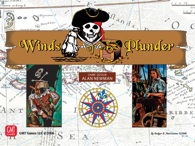Winds of Plunder – Boardgame Review
 Winds of Plunder. GMT Games. Designed by Alan Newman. $45.00
Winds of Plunder. GMT Games. Designed by Alan Newman. $45.00
Passed Inspection: Entertaining, with minimal down time for players
Failed Basic: Slightly mechanical feel to gameplay
The map is a mounted, full-color… four-panel, fold-out depicting the 18th century Caribbean from Belize to Barbados to Trinidad to Nassau.
Winds of Plunder, GMT’s second Euro-style offering, is a pirate game set in the Caribbean. It is a medium-complexity, three-to-five player game that takes about an hour and a half to play the nine turns (called rounds). Rounds are short enough that player downtime is minimal and there is some player interaction at the start of the turn so that the game doesn’t play like so many multiplayer solitaire games.
{default}The components are competent but not up to GMT’s usual high standards. For some reason, the box itself is unusually thick. The map is a mounted, full-color (dull pastels and light blue), four-panel, fold-out depicting the 18th century Caribbean from Belize to Barbados to Trinidad to Nassau. Each port is assigned a face up Victory Point tile that indicates the prizes and victory points available there. Tiles are replaced as visiting pirates collect them.
The two dominating features are the four north-south longitude zones, and the 12 ports located within in them. By necessity, there are three ports per zone, and their latitude (the north and south relationship to each other) actually matters since the ships sail in a restrictive longitude and latitude combination. The map’s rim contains four scoring ladders (with a consistent motif of a pirate ship) along with a victory-point track. The sturdy, 110-card deck will hold up without additional protection. Its graphics are not stunning but have clear captions and explanations. There are no cardboard counters; instead, players use Risk-like wooden cubes that serve several purposes, including port visitation and wind control. The pirate ships are also made of wood, and each player gets a compass to record the wind direction. Finally, there is a Blackbeard tile, used to identify the first player for the turn and for breaking ties.
The 12 pages of rules (actually, each translation of the five languages is 12 pages) look complex at first but after two rounds of play, each procedure should be clear enough. After that, you won’t need the rules much. Each round plays in two parts: The Wind Phase and the Plundering Phase.
In the Wind Phase, players vote for the wind direction by secretly recording it on their compasses, with everyone’s choice revealed at the same time. Once revealed, players then vote for the actual direction in another voting round. Who knew that pirates had so much control over the weather? This time, they allocate any number of wooden cubes (appropriately called wind cubes) but they can only directly vote for the direction they initially chose. This means you may not want to cast cubes in your direction, hoping that another one will win.
This voting serves two purposes. First, the wind direction receiving the most cubes is the direction for the turn. Second, the player revealing the most cubes gets the Blackbeard tile for the turn. Among other capabilities, whoever holds this tile chooses the first player for the round and often select himself to be move first.
[continued on next page]
Pages: 1 2

